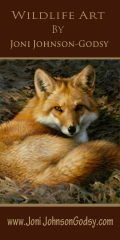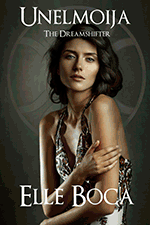Luxury Travel Review

Spanish wines we sampled via New Mexico
By Elena del Valle
Photos by Gary Cox

The non vintage Silverhead Brut our favorite
In celebration of health, life, peace and hope we made time to taste three Spanish wine samples we received from Vara Winery & Distillery in New Mexico (315 Alameda Boulevard NE Albuquerque, New Mexico 87113, +1-805-815-7693, https://varawines.com/). Vara sells 12 types of Spanish and American wines bottled in Albuquerque.
We tasted the Garnacha Rosado 2018, Tempranillo 2018, and non vintage Silverhead Brut on separate occasions. While we liked all three the cava was our favorite.
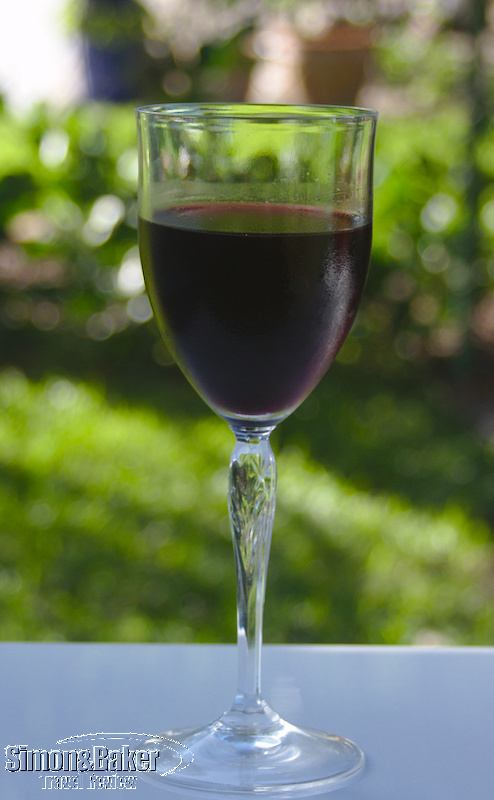
The Tempranillo consisted of 82 percent tempranillo and 18 percent garnacha grapes.
The Silverhead Brut, made with the Cava Método Tradicional, was refreshing, lightly fruity, well balanced, easy to drink. It had a pleasing pale yellow color and stood on its own with a clean finish. It paired well with fresh Florida stone crabs, fish dip and a green salad. We liked it best chilled although it held up well after a few minutes.
The lightly chilled Garnacha was a success with poultry and vegetable soup, even foie gras mousse. Its medium to light intensity held up to the flavors of the dishes without overpowering them. It had a mild finish. It was made with 100 percent garnacha grapes harvested from Viñedos de Santo Cristo and Campo de Borja in Spain.
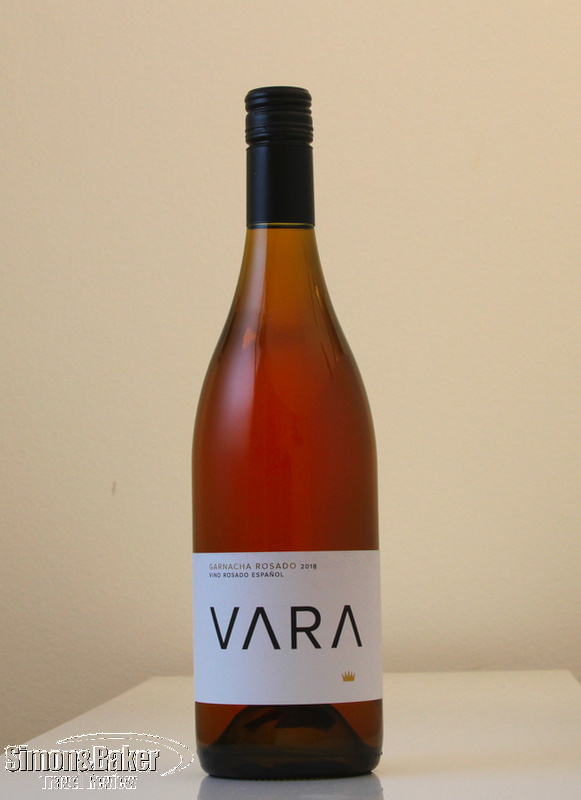
We first tasted the Garnacha Rosado 2018.
The Tempranillo, a red wine made from the same vineyards as the Garnacha, consisted of 82 percent tempranillo and 18 percent garnacha grapes. Its deep red with a hint of purple promised a full bodied wine. On its own it was good with a gentle finish. It paired well with grilled German bratwurst and homemade fries. It was stout enough to match with sauerkraut.
“Vara means cane in Spanish, King Philip of Spain gave the Vara, Cane of Sovereignty, to the 19 northern pueblos of New Mexico, a huge honor,” said Doug Diefenthaler, co-founder, Vara Winery & Distillery, by email through his publicist in response to questions about the winery and its products. “Our grapes for our Spanish wines are estate grown, harvested, and made fermentation stable in Campo de Borja, Spain before bringing the wine here to our winery for barreling, blending, finishing, and bottling.”

The slightly chilled Garnacha
Diefenthaler, who is executive vice president of the company, co-founded it with Xavier Zamarripa, an artist. Vara has wine making directorial privileges at a facility in Ainzon, Campo de Borja, Spain in order to process and ferment its wines near the vineyard source.
Snorkeling, diving enthusiasts release Palm Beach guide

Palm Beach Florida Scuba Dive, Snorkel, Surf (Mango Publishing Group, $34.99) features detailed descriptions, photos and crisp 3D images of waterscapes, including underwater maps and even a ghost ship recreation for a wreck dive description. The 287-page softcover color book by Peter McDougall, Ian Popple and Otto Wagner, part of the Reef Smart Guides series, was published in 2019. The authors are part of the Reef Smart Guides management team.
Why Palm Beach county? “We’re looking for hidden gems and Palm Beach was one of those areas,” Popple, credited in the book for series concept and writing, said by phone from Canada. “Most of the diving you do in Palm Beach County is drift diving.”
The marine biologist explained that the conditions in Palm Beach County required the team to change their techniques. The three men rely on global positioning systems and photogrammetry (using photos to make maps and surveys) to create 3D images. Those images are converted into 2D images in the book. They took a series of photos from which they created a 360 degree view of each underwater area highlighted.
Print books are popular because electronic devices can’t get wet and are easily stolen, he explained. Having a clear idea of snorkel and dive sites ahead of time is helpful because planning is an important element in diving, he added.
Following an introduction to Palm Beach County the book is divided into two main sections Surf breaks and Diving and snorkeling. It also has information on area sea turtles and dozens of fish profiles. The diving and snorkeling section is much longer than the surfing section. The book features detailed information of individual surf, dive and snorkel sites. Each dive site description includes computer generated images, access, reef and wreck details and a rating from one to three for difficulty, current and depth as well as one to three star ratings for reef and fauna.
The Palm beach guidebook contains 46 photos, 15 illustrations, 92 species profiles and 71 3D maps featuring 31 dive and snorkel sites, some of which are sites with multiple wrecks. The Blue Heron Bridge snorkel and dive site featured in the book is “One of the best shore dives in the world,” Popple said.
Reef Smart offers marine and shipwreck guides for divers, surfers and snorkelers. The first Reef Guide book was about Bonaire, “the shore diving capital of the world,” according to Popple. The company also offers services and training to resorts. The authors received support (flights and accommodations) from Discover the Palm Beaches, the county’s tourism promotion entity, and some dive operators.
At our request Popple shared his thoughts on the top three surf, snorkel and dive sites in Palm Beach. For surfing, “Reef Road is the spot that most people both inside and outside of Palm Beach will have heard of,” he said. “It’s by far the best spot in county. It’s a location better suited to more experienced surfers though, especially the adjacent site across the inlet called Pump House, which may only peak on a couple of day of the year, but when it does it’s the place to be.” He also mentioned Lake worth Pier for its consistency and Juno Pier (and the stretch up to Jupiter inlet) for decent breaks when the conditions are right.
For snorkeling: Blue Heron Bridge, Ocean Reef Park and The Lofthus wreck were his picks. About the Blue Heron Bridge he said, “You never know what you’re going to find at this site, anything from seahorses to eagle rays and it’s all located within a protected swimming area.”
“Just off the public beach is a several small patch reefs that support a surprising amount of marine life, including stingrays, small morays and schooling of grunts and snapper,” he said about Ocean Reef Park, adding that there is plenty of parking, a life guard tower, and showers.
About the Lofthus wreck he said, “It’s a hike up the beach, but it’s a fun site to explore and there’s an interesting history to the site (it’s one of Florida’s archaeological preserves) and there’s always the chance of running into something large (e.g. barracuda, nurse shark, sting ray). The downside is that shifting sand bars mean that sometimes large parts of the wreck can be obscured by sediment.”
His top diving picks are: Blue Heron Bridge, The Mitzpah corridor and MV Castor. About the Blue Heron Bridge he said, “This shore dive has to be one of the best in the world and you might be surprised to find it in Palm Beach. It’s a protected area with tons of cryptic species like frogfish, seahorses, and batfish. Because it’s so shallow you can spend a long time underwater exploring the site.”
The Mitzpah corridor is “the mother of all wreck treks,” he said. “Starting at the Ana Ceceilia you can drift for the whole dive from one wreck to the next, a total of five, ranging in size; the largest being the massive Amaryllis, which is 440 feet in length.”
MV Castor “is the wreck that most people want to visit when they dive Palm Beach,” he said. “The ship was a freighter sunk in 2001. The ship has broke into separate bow and stern sections with a debris field of hull plates between. The wreck is famous for it’s giant goliath grouper and during spawning season there can be over 50 present there. You literally never know what you might find when you enter the water here.”
When asked how much influence the tourism authority, hotels and dive operators his team worked with had on the editorial content of the book he replied, “They didn’t. The tourism authority helped facilitate our mapping trip, by organizing flights and places to stay locally, but had no say on the content of the book and neither did the hotels where we stayed. The dive centers advised us on which sites we should map, but again, had no editorial input.”
Palm beach is the team’s fourth guidebook. Next are Grand Cayman in the spring, and the Florida panhandle in the fall; followed by guide books on the sister islands Little Cayman and Cayman Brac, Florida keys, Grenada, and Curaçao.

The Reef Smart team
Born and raised in Canada, McDougall received his undergraduate and master’s degrees from McGill University. His focus on behavioral ecology and coral reef ecology led him to two field seasons at Bellairs Research Institute in Barbados, in 1999 and 2002. After graduating in 2003, he moved to the United States and began a career in science communication and writing, publishing in peer-reviewed academic journals and the popular press. He has written on a variety of coastal ecosystem issues, including extensive work surrounding the science of ocean acidification. He is a PADI Rescue Diver with over 300 dives in 19 years of experience.
Popple was born and raised in the United Kingdom, where he earned his undergraduate degree in oceanography from the University of Plymouth in 1994. He worked for five years at Bellairs Research Institute in Barbados, supporting research projects across the region, before completing his master’s in marine biology at McGill University in 2004. He co-founded a marine biology education company, Beautiful Oceans, before founding Reef Smart in 2015 to raise awareness and encourage people to explore the underwater world. He has published in the scientific and mainstream media, including National Geographic, Scuba Diver Magazine and The Globe and Mail. He is a PADI Dive Master with over 3,000 dives in 25 years of diving experience.
Wagner was born and raised in Romania. He graduated from the University of Art and Design in Cluj, Romania in 1991. In 1999, he moved to Canada, where he studied Film Animation at Concordia University in Montreal. In 2006, he turned to underwater cartography and pioneered new techniques in 3D visual mapping. He co-founded Art to Media and began mapping underwater habitats around the world. He received the Prize of Excellence in Design from the Salon International du Design de Montréal. He has also illustrated seven books. Wagner is a PADI Advanced Diver with over 500 dives in 15 years of diving experience.
Photos courtesy Reef Smart

Click to buy Reef Smart Guides Florida: Palm Beach: Scuba Dive. Snorkel. Surf.
Tasman helicopter flight trip highlight
We were the only people at Wharariki Beach – click to expand to full size
Article and photos by Elena del Valle
My off the beaten track Intrepid tour of the South Island (Te Waipounamu) of New Zealand began in Nelson. I was originally supposed to fly from the Nelson airport to the Westhaven Retreat by helicopter following a domestic flight into Nelson. It would have been faster than the multi-hour drive. Most importantly we would soar above the popular Tasman National Park, the smallest national park in New Zealand and one of the most popular.

Pilot Logan Moore standing in front of the Eurocopter EC120 at Westhaven Retreat
When a series of wildfires broke out near Nelson I anticipated my helicopter flight would be cancelled and it was. While I enjoyed the drive with my guide (Veronika Vermeulen, owner, Aroha New Zealand Tours) because it allowed me to get to know her and see a bit of the country, I was disappointed at having missed the helicopter flight. Fortunately, Veronika found a work around.
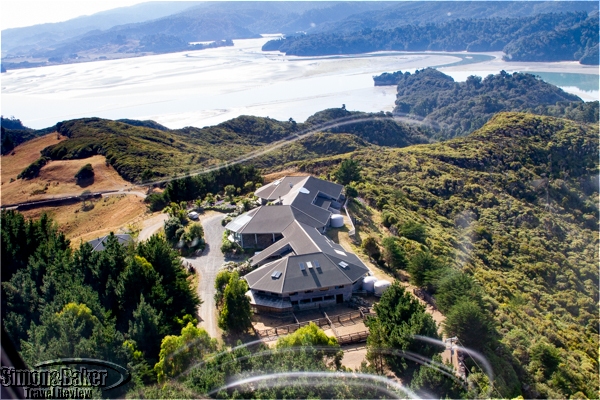
Our view of Westhaven Retreat as we departed
She scheduled the private Top of the South Tour on our departure. To make it possible on our departure day she left Westhaven Retreat early in the morning in the sports utility vehicle with our luggage. I stayed behind to enjoy a leisurely breakfast and the pretty ocean vistas. A few minutes after breakfast, from the expansive windows of the Westhaven dining room, I spotted a tiny metal bird approaching. In the blink of an eye the other guests and I watched it land on the nearby lawn.

At the Mount Olympus Lord of the Rings film site
Within minutes Logan Moore, chief executive officer and pilot of Tasman Helicopters (Tangmere place, Nelson Airport www.tasmanhelicopters.co.nz, info@tasmanhelicopters.co.nz, 035288075) and I were airborne. From departure to arrival we didn’t see a soul. We flew in a Eurocopter EC120 built in 2008 with just over 2,000 flight hours and capacity for four passengers.


We flew over coastal areas, some isolated and some well populated
The 90-minute flight was one of the highlights of my trip to New Zealand. We stopped twice, at Wharariki Beach and at the Mount Olympus Lord of the Rings film site. I especially loved the dazzling beach stop. For a few minutes I had the impression we were the only humans for miles on the beautiful and unspoiled beach. Minutes later we landed in a rocky and hilly landscape. As soon as Logan identified which Lord of the Rings movie the film site belonged to I recognized it. The video clip on his tablet confirmed it.

During a coffee break at Motueka Airport
Tasman Helicopters, co-owned by Ross Moore and Logan Moore, was established in 2015. According to Logan, who responded to questions by email, the company had no safety incidents.
Thanks to nice weather the scenery sparkled. The sky was clear and the flight was smooth, making time disappear faster than I anticipated. We landed at Motueka Airport, where my guide awaited me. As we continued on my tour memories of the flight lingered.
From US to NZ on Virgin Australia International Long Haul Premium

Middle seats on the better than economy section
I was thrilled at the prospect of visiting New Zealand, but finding a comfortable flight from the United States to New Zealand that didn’t break my travel spirit because of the length of the flight or my budget was so challenging I almost cancelled my trip. Although flying time on the United States to New Zealand flights was better than the longer flying time required on flights with connections en route to New Zealand the cost of the United States to New Zealand flights was 30 percent or more greater than I wanted to spend, and that was for an economy seat. Given the length of travel (some itineraries I found, alone and with the help of “expert” travel agents, exceeded 50 hours of travel, including sometimes 12 hour and longer layovers) I wanted something better than economy.
After days of searching and talking to 12 or more airline and travel specialists I found a combination of flying time, comfort and price I could live with on Virgin Australia International. Unfortunately the only routing possible was through Los Angeles. That airport, I soon discovered, was undergoing renovations involving extensive construction work.
Despite my best efforts and hours long conversations with the carrier it was impossible to book the flight as a single ticket from my departure airport. With the aid of a supervisor I booked two domestic connections to Los Angeles as a stand alone ticket. From there I flew Virgin Australia International to New Zealand via Australia on its slightly better than economy class fare, International Long Haul Premium.

The Virgin Australia amenity kit
Arriving at LAX while it was under construction was no fun. As there was no universal agreement on the amount of time necessary for me to connect from my domestic to my international flights (three hours minimum was the common advice, more if possible) I booked an extra long layover. Once I was off of my domestic flight I had to collect my luggage from the domestic flight terminal, exit, make my way to another concourse (it was rather challenging to discover the path or distance involved in advance), pass through security, and check in for my Virgin Australia flight.
The lounge at LAX where I waited for my connection looked tired and unimpressive. As boarding time neared I was eager to board the flight to Brisbane although it meant the longest connection in my trip. Once on the aircraft the section set aside for Premium economy passengers looked slightly better than I had dared hope. I was in an aisle seat in row 16. The seat leaned back partway and was comfortable enough although the ambient temperature was uncomfortably chilly for most of the flight. Even my neighbor, a tall man from the Midwest used to cold winters, made use of the small synthetic fabric that passed for a “luxurious” blanket. The return flight to Los Angeles from Australia had the same uncomfortable frigid conditions.


In order to carry fewer items on the trip I left my noise canceling headphones at home and was pleased to find a headset for my use on board.
Amenities included 41 inch seat pitch and nine inch recline, according to the airline’s website (I didn’t measure them); as well as 10.6 inch Seatback In-flight entertainment screen, noise cancelling headset, in-seat electrical power and USB connectivity. My entertainment system was functional as was the headset on both flights. The flights from Australia to New Zealand and back were Economy.
On the International Long Haul Premium flights everything was much better than on the Economy service for the same carrier. Although the printed menu promised delicious meals when they arrived it was the usual overcooked airline food. After the meal service and before the pre-landing snack a few self-serve snacks and beverages were available from a refrigerator. After a while the snacks disappeared. My favorite was the dark chocolate and coconut bar, an Australian flavor of a well known brand. Only one was on offer on my United States bound flight. On the outbound flight I didn’t sample any wines. On the return, they were out of the New Zealand wine of my choice from the wine list.

The staff were friendly and attentive on departure. After that the service waned. The first flight from the United States to Brisbane, Australia offered the best service of the four Virgin Australia International flights. It was far superior than the service on the domestic carrier stateside.


My hours of travel were long and I was exhausted on arrival in New Zealand to a crowded airport with long lines, brusque and impatient staff and strict customs rules. The 30 percent savings in the airfare combined with the shorter flying hours, slight onboard comforts, extra space and intimate section (the Premium seats were in a section of their own between business and economy) made the purchase worthwhile. Overall I was pleased with my selection of flights and ticket price. Based on the two flights from LAX to Australia I would fly Virgin Australia International’s International Long Haul Premium again.
Book showcases Florida wildflowers

Complete Guide to Florida Wildflowers*
Visitors to Florida have a new tool to identify wildflowers. In the Complete Guide to Florida Wildflowers Over 600 Wildflowers of the Sunshine State including National Parks, Forests, Preserves, and More than 160 State Parks (Falcon Guides, $29.95) Roger L. Hammer, a career naturalist based in Homestead, shared color photos of 686 Florida native wildflowers.
“I chose to omit naturalized exotic species and native woody shrubs and trees, concentrating mostly on herbaceous wildflowers,” Hammer said by email about the photos in the 378-page softcover book published in 2018. “The book took 12 months to complete, but I had a head start by already having published guides that covered central and southern Florida, so I only needed to concentrate on northern Florida and the Panhandle.”
Hammer took all of the photos using a Nikon D810 digital camera with a Nikkor 105 millimeter macro lens. The book is divided into an introduction and six sections. The sections feature flowers by color: blue and purple, pink, red and orange, yellow, brown and green, and white. Each page is dedicated to two flowers. A color photo of the flower occupies the top half followed by the name, description, season when it blooms, where it can be found, and comments.
“The greatest challenge was driving up to the Florida Panhandle about a dozen times from Homestead and back, which takes between 10 and 14 hours one-way, then spending a week up there, driving back home, and then heading back the following month,” Hammer said. “Locating some of the rare wildflowers up there was also challenging, but I relied on botanist friends who live in the Panhandle, and also rangers in some of the state parks.

Roger L. Hammer, author, Complete Guide to Florida Wildflowers
My first love affair with Florida wildflowers was with native orchids, so it was a thrill to photograph species of orchids that I had not seen before. Of the 110 native orchids in Florida, I have now photographed 96 of them. Also, I was able to include all 21 native milkweeds (Asclepias), all 10 native mints in the genus Dicerandra, all 5 milkvines (Matelea), and all 4 species of wakerobins (Trillium). There are many other wildflowers included in this guide that have never appeared in field guides before.”
How can beginners who want to identify a wildflower begin? “Readers should become familiar with botanical names, which they can then use to search the University of South Florida’s Florida Plant Atlas,” he said. “There they will find a range map, common names, botanical synonyms, and a photo gallery. It is one of the more useful websites for Florida’s native and naturalized flora, .florida.plantatlas.usf.edu”

The Butterfly orchid
For orchid lovers the following common species can be seen without too much effort, according to the author. The Tuberous grass-pink orchid (Calopogon tuberosus) can be found in spring in wet, grassy prairies and pine flatwoods throughout mainland Florida. The Butterfly orchid (Encyclia tampensis) flowers in summer and is frequent on trees in upland forests and coastal buttonwood-mangrove forests from north-central Florida south into the Florida Keys. The Spring ladies’-tresses (Spiranthes vernalis) is common along roadsides and in grassy prairies throughout mainland Florida and flowers in spring.
Hammer is a survivalist instructor for the Discovery Channel’s reality TV show Naked and Afraid. He was the manager of the 120-acre Castellow Hammock Nature Center for the Miami-Dade County Parks Department for 30 years. In addition to the new book he is the author of Everglades Wildflowers, Florida Keys Wildflowers, Central Florida Wildflowers, Attracting Hummingbirds and Butterflies in Tropical Florida, Exploring Everglades National Park, and Paddling Everglades and Biscayne National Parks. He lives in Homestead with his wife, Michelle.
*Photos courtesy of Falcon Guides, Paul Marcellini, Roger Hammer
My sweet Kiwi souvenirs
By Elena del Valle
Photos by Gary Cox

My favorite manuka honey was Mangarakau Gold from Westhaven Retreat
Soon after I arrived in the South Island of New Zealand for an Intrepid tour I sampled a spoonful of dark brown crusty honey with a hint of bitterness that captured my interest. It was an inconspicuous self sampling of Mangarakau Gold from an open container at the reception desk at Westhaven Retreat that made me stop and pay attention to New Zealand’s claim to honey fame, manuka. I bought a jar. I had passed by honey products advertised in many places in Christchurch before that. I have sampled many honeys over the years. This tasted special.
I bought a small jar of manuka honey at a health food store in Lyttleton near Christchurch in the South Island. The honey I bought at Westhaven, labeled Mangarakau Gold, is in a plastic jar. At 500 grams it is the largest of the three and my favorite despite (or perhaps because of) its hint of bitterness. The second honey, labeled Rochfort Downs, is in a 250 gram plastic container. Aotea, the store bought honey, is in an 80 gram glass jar. According to the label, it was processed by hand from hives on Aotea Great Barrier Island. It includes a batch number. There was no response to emails at the Aotea honey address. The Rochfort Downs and Aotea labels indicate they have 300+ MGO.

I bought a small jar of manuka honey at a health food store in Lyttleton.
Once home I tried the Westhaven honey as well as honey from Birds Ferry Lodge, clover honey from Cabot Lodge and the Aotea honey. Each one is distinct and slightly different from the others. This is especially the case with the Cathedral Peaks Honey, because it is clover rather than manuka honey, from Cabot Lodge. It was harvested by one of the owners on the 2,000 acre property. As their regular product was not ready for the public they kindly shared a 100 gram bottle (labeled Meant to B) from their recent wedding.
When I asked them about their honey they replied, “Brad’s family is heavily involved in agriculture and horticulture, his great grandfather was a prize ram breeder, his father is a large avocado and capsicum grower and his uncle is a beekeeper. For a while Brad left behind his agricultural roots to pursue a corporate career, but he always felt something was missing. One night he rolled over in bed and told me he wanted to become a beekeeper. I thought he was joking, as at that time we lived in the middle of Auckland City. He borrowed a few beehives from his father, and began to learn the art of beekeeping. Within six months he was determined to make it a career, and within 12 months we had packed our bags, moved to the other end of New Zealand to my parents farm, and Brad purchased 75 hives to begin his beekeeping dreams.”

The Rochfort Downs honey in a 250 gram plastic container
Although I sampled the original manuka honey several times and the others I picked up on that trip I can’t put my finger on what it is that I like about them. In the end I decided to stop trying and savor the flavor along with the pleasant memories of my trip to New Zealand the honey evokes.
People I spoke with on my journey explained that manuka is known for its healing properties, wound healing in particular. Online resources tout its benefits for oral health, sore throat, digestive issues and other conditions (see 7 Health Benefits of Manuka Honey, Based on Science by Kaitlyn Berkheiser, a registered dietitian, published March 29, 2018 on Healthline.com) and a honey expert I spoke with support the concept.

Clover honey from Cabot Lodge
While stateside honey is considered only a natural sweetener, not a drug, some believe honey, and manuka honey in particular, has healing properties. It has apparently been successfully used to treat wounds. Michele Colopy, program director, Pollinator Stewardship Council, an Akron, Ohio non profit organization, confirmed that credible sources describe manuka honey as having high concentrations of methylglyoxal (MGO), an antimicrobial and antibacterial naturally occurring substance described in the manuka honey bottles. Some believe that the higher the MGO concentration the greater the healing power of the honey.
She clarified that any honey, even those described as monofloral (made from a single type of flower such as orange blossom or lavender, for example), is the product of more than one type of flower. Bees get bored, and, it’s unhealthy for them to rely exclusively on a single plant source for nutrients, she explained by phone.

The thick and dark manuka honeys and the light colored clover honey
All four honeys I sampled where from small producers. Unless I return to New Zealand for another visit it will be difficult to buy more manuka honey from those small producers. The good news is that since my return home I have noticed many local stores have New Zealand manuka honey. Should I run out it will be easy to buy more even if it’s likely to be from large commercial producers. The honey I have left (more than I will eat in a year) will keep forever. Michele pointed out that honey never spoils. It would be possible to eat honey from the Egyptian tombs without any ills effects, she said. While I have no (immediate) plans to test honey from tombs for now I’m happy to occasionally enjoy a spoonful of thick liquid sweetness harvested by New Zealand honey bees. And if the honey includes healing benefits the better.


